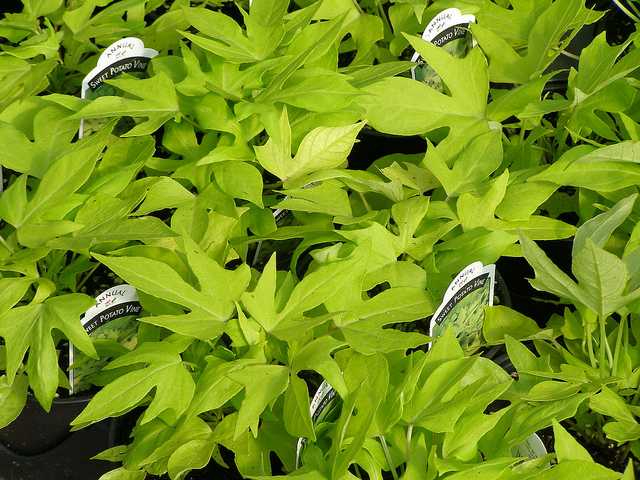
The sweet potato is a warm-season, spreading veggie. Since it is easy to grow, it is a good choice for a garden. In addition, the sweet potato doesn’t have lots of pests or disease and is also very low in calories and nutritious. They like warm soil, unlike regular potatoes, which grow best when the soil is cool. The sweet potatoes are tropical plants which are sensitive to cold weather. Many gardeners, who live in places with warm climates, plant sweet potatoes about 1 month after the last spring frost, when both the soil and air are dependably warm. Since the plants produce lush vines, they are a great crop for beds.
When to plant
Sweet potatoes are grown from slips, which are sprouts taken from the tubers. Locate some tubers which have not been treated to prevent sprouting. Half bury them in a pan or box of rooting medium or suspend a potato with toothpick halfway into a water-filled jar, some 6 to 8 weeks before planting. In order to be successful, you should keep these potato parents moist and at a temperature between 75 and 80 degrees F. After approximately a month, the first shoots will occur.
Cut them from the parent potato when they are about 6 to 9 inches long, and dispose of the bottom inch from each slip, because this segment sometimes harbors disease organisms. Sweet potatoes can grow in poor soil where most other vegetables can’t, but yields from such plots will be sparse. They do best in a well-drained sandy load with a clay. A too- light soil creates long, stringy tubers, while heavy clay, unless well-worked, produces misshapen roots.
How to plant
Prepare the sweet potato bed around the time of the last spring frost in a full-sun area. Dig the ground to a depth of 8 to 12 inches in order to allow the long roots of tubers to make use of moisture deep in the earth. Many gardeners prefer to plant in long, wide ridges which are at least ten inches high in order to provide the loose soil, which is so essential to good tuber development. Normally, rows are spaced around three and a half feet apart.
Remove all dirt clods and rocks, and work in average amounts of rock phosphate or compost and wood ashes. Materials which are rich in potassium will help the potatoes fill out properly, however, unless you are planting in very sandy soil, go easy with nitrogen-rich fertilizers that will stunt tuber development, encourage lush vines, and combined with excessive rainfall – can delay maturation. Sweet potatoes are fond of a slightly to moderately acid soil, which has pH between 5.2 and 6.7.
Once the earth has warmed up, use a hoe handle to poke holes about 6 inches deep and twelve inches apart, usually 3 to 4 weeks after the last frost. Bury the slips up to the last leaves and before you water thoroughly, tamp down the dirt gently but well. Mulch heavily with hay or grass clippings some two weeks later in order to eliminate the need for weeding and watering and to keep the soil soft for the development of the root.
It won’t take long before the thick, sprawling vines smother most invading weeds. It is recommended that you lift the longer vines in order to prevent them from rooting at the joints. In case the rain is scarce, try to provide one inch of water one to two weeks before harvesting. However, be careful! This veggie survives dry spells very well, and for that reason over watering could encourage rot. Otherwise, you can usually forget about them until harvest time once the plants are established, because despite all the diseases and pests which attack this crop, it is usually remarkably trouble-free.
Harvest and store
The longer they stay in the ground, the high the vitamin content and the richer the yield. But, once the vines are blackened by frost, the tubers easily become vulnerable to rot. For that reason, it is best to dig the potatoes soon after the leaves begin to yellow, unless you can harvest immediately after the first cold spell. Do it on a sunny day when the soil is dry, since roots which are harvested when the ground is wet can shrink considerably when they are stored.
Start digging from the outside of the row with a spading fork, because sweet potatoes can be found growing a foot or more from the plant. Keep in mind that any cuts in the tender skins will encourage spoilage. Leave the tubers on the ground after digging for a few hours – but no longer – and then move them to a place, which is well-ventilated, with temperature at around 85 to 90 degrees F, for ten to fifteen days.
Once cured, store the sweet potatoes at around 60 degrees F with a humidity of around 80%. If they are cured and stored well, the sweet potatoes will keep for a few months, especially if handled as little as possible until they’re ready to be used.



